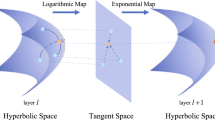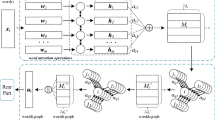Abstract
We present a structural attention network (SAN) for graph modeling, which is a novel approach to learn node representations based on graph attention networks (GATs), with the introduction of two improvements specially designed for graph-structured data. The transition matrix was used to differentiate the structures between the nodes. The output features of nodes in the graph are represented as the concatenation of multi-order features to differentiate the structures among multiple orders. This novel neural network is based on a graph attention network, which makes the model pay attention to the topology of the graph. Using various experiments on citation networks and a protein-protein interaction dataset, we demonstrate the benefits of structural information in graph attention mechanisms.






Similar content being viewed by others
References
He K, Zhang X, Ren S, Sun J (2016) Deep residual learning for image recognition. In: Proceedings of the IEEE conference on computer vision and pattern recognition, pp 770–778
Zhang Y, Pezeshki M, Brakel P et al (2016) Towards end-to-end speech recognition with deep convolutional neural networks. In: Interspeech conference, San Francisco, pp 410–414
Conneau A, Schwenk H, Barrault L, et al (2017) Very deep convolutional networks for text classification european chapter of the association for computational linguistics EACL’17
LeCun Y, Bengio Y, Hinton G (2015) Deep learning. Nature 521(7553):436–444
Niepert M, Ahmed M, Kutzkov K (2016) Learning convolutional neural networks for graphs. In: International conference on machine learning(ICML), New York, pp 2014–2023
Hamilton W, Ying Z, Leskovec J (2017) Inductive representation learning on large graphs. Advances in neural information processing systems. pp 1024–1034
Hochreiter S, Schmidhuber J (1997) Long short-term memory. Neural Comput 9(8):1735–1780
Bahdanau D, Cho K, Bengio Y (2015) Neural machine translation by jointly learning to align and translate International Conference on Learning representations(ICLR)
Gehring J, Auli M, Grangier D et al (2017) A convolutional encoder model for neural machine translation. In: Proceedings of the 55th annual meeting of the association for computational linguistics, vol 1, pp 123–135
Yuan J, Gao N, Xiang J (2019) Transgate: knowledge graph embedding with shared gate structure[J]. In: Proceedings of the AAAI conference on artificial intelligence, vol 33, pp 3100–3107
Velickovic P, Cucurull G, Casanova A et al (2018) Graph attention networks. International conference on learning representations (ICLR)
Vaswani A, Shazeer N, Parmar N et al (2017) Attention is all you need. In: Proceedings of the 31st International Conference on Neural Information Processing Systems. Curran Associates Inc, pp 5998–6008
Mikolov T, Chen K, Corrado G, Dean J (2013) Efficient estimation of word representations in vector space. arXiv:1301.3781
Hechtlinger Y, Chakravarti P, Qin J (2017) A generalization of convolutional neural networks to graph-structured data. arXiv:1704.08165
Cao S, Lu W, Xu Q (2015) Grarep: Learning graph representations with global structural information. In: Proceedings of the 24th ACM international on conference on information and knowledge management, pp 891–900
Gori M, Monfardini G, Scarselli FA (2005) New model for learning in graph domains. In: IEEE international joint conference on neural networks, IEEE
Scarselli F, Gori M, Tsoi AC et al (2009) The graph neural network model. IEEE Trans Neural Netw 20(1):61–80
Bruna J, Zaremba W, Szlam A et al (2014) Spectral networks and locally connected networks on graphs. In: International conference on learning representations (ICLR2014)
Edwards M, Xie X (2016) Graph based convolutional neural network. arXiv:1609.08965
Defferrard M, Bresson X, Vandergheynst P (2016) Convolutional neural networks on graphs with fast localized spectral filtering. In: Proceedings of the 30th international conference on neural information processing systems. Curran Associates Inc, pp 3844–3852
Kipf TN, Welling M (2017) Semi-Supervised classification with graph convolutional networks. In: International conference on learning representations (ICLR)
Atwood J, networks Towsley D. (2016) Diffusion-convolutional neural. In: Proceedings of the 30th international conference on neural information processing systems. Curran Associates Inc, pp 2001–2009
Perozzi B, Al-Rfou R, Skiena S (2014) Deepwalk: online learning of social representations. In: Proceedings of the 20th ACM SIGKDD international conference on knowledge discovery and data mining, pp 701–710
Grover A, Leskovec J (2016) node2vec: scalable feature learning for networks. In: Proceedings of the 22nd ACM SIGKDD international conference on knowledge discovery and data mining, pp 855–864
Cao S, Lu W, Xu Q (2016) Deep neural networks for learning graph representations. In: Proceedings of the Thirtieth AAAI conference on artificial intelligence, pp 1145–1152
Luong MT, Pham H, Manning CD (2015) Effective approaches to attention-based neural machine translation. In: Proceedings of the 2015 conference on empirical methods in natural language processing, Lisbon, pp 1412–1421
Shaw P, Uszkoreit J, Vaswani A (2018) Self-attention with relative position representations. In: Proceedings of the 2018 conference of the North American chapter of the association for computational linguistics: human language technologies, vol 2, pp 464–468
Page L, Brin S, Motwani R, Winograd T The PageRank citation ranking: Bringing order to the Web. Technical report, Stanford Digital Library Technologies Project. citeseer.ist.psu.edu/page98pagerank.html
Sen P, Namata G, Bilgic M, et al (2008) Collective classification in network data. AI Mag 29(3):93–107
Lu Q, Getoor L (2003) Link-based classification. In: Proceedings of the 20th international conference on machine learning(ICML)., pp 496–503
Yang Z, Cohen WW, Salakhutdinov R (2016) Revisiting semi-supervised learning with graph embeddings. In: Proceedings of the 33rd international conference on international conference on machine learning, vol 48, pp 40–48
Wang X, Girshick R, Gupta A, et al (2018) Non-local neural networks. In: Conference on computer vision and pattern recognition(CVPR). IEEE, pp 7794–7803
Wang J, Guo Y, Wen X, et al (2020) Improving graph-based label propagation algorithm with group partition for fraud detection. Appl Intell. https://doi.org/10.1007/s10489-020-01724-1
Gao H, Wang Z, Ji S (2018) Large-scale learnable graph convolutional networks. In: The 24th ACM SIGKDD international conference ACM
Yang L, Kang Z, Cao X et al (2019) Topology optimization based graph convolutional network[C]//IJCAI. pp 4054–4061
Chen Y, Rohrbach M, Yan Z et al (2019) Graph-based global reasoning networks[C]//2019. In: IEEE conference on computer vision and pattern recognition(CVPR), pp 433–442
Zhao L, Akoglu L (2020) Connecting graph convolutional networks and graph-regularized PCA[J]. arXiv:2006.12294
Hu F, Zhu Y, Wu S, et al (2019) Hierarchical graph convolutional networks for semi-supervised node classification[J]. arXiv:1902.06667
Velickovic P, Fedus W, Hamilton WL, et al (2019) Deep graph infomax[c]//ICLR (Poster)
Acknowledgments
The authors thank the reviewers for their helpful comments, and the authors of GATs for making the source code of their approaches publicly available. Yifen Li have received funding from the Changsha Vocational&Technical College’s education research and innovation programme under grant agreement CZJG19QN01.
Author information
Authors and Affiliations
Corresponding author
Additional information
Publisher’s note
Springer Nature remains neutral with regard to jurisdictional claims in published maps and institutional affiliations.
Rights and permissions
About this article
Cite this article
Zhou, A., Li, Y. Structural attention network for graph. Appl Intell 51, 6255–6264 (2021). https://doi.org/10.1007/s10489-021-02214-8
Accepted:
Published:
Issue Date:
DOI: https://doi.org/10.1007/s10489-021-02214-8




